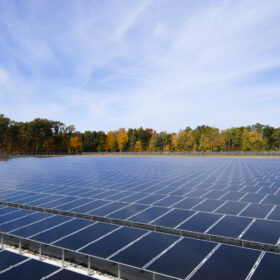Slipping the resolution through in the final days of the year, the Idaho Public Utilities Commission (PUC) passed a resolution to cut net energy metering for rooftop solar. The new rulemaking decision also approved electric rate increases that are expected to disproportionately impact low-income customers.
Net energy metering (NEM) involves the electric utility providing credit to rooftop solar customers for delivering electricity to the grid. It is an essential factor in the return on investment for rooftop solar and helps encourage local sharing of clean energy.
Utility Idaho Power will no longer be required to pay retail rates for net-metered electricity, instead shifting to a net billing format. The Sierra Club estimates that the new average annual net billing rate will be under $0.06 per kWh.
Over the past decade-plus, the United States has launched its residential solar industry, bringing predictable and often low-cost, local, and clean energy to homeowner’s rooftops. Rooftop solar is a source of financial stability for customers, and for its tens of thousands of employees, it has created decent paying jobs.
Idaho now follows California in slashing NEM. The move caused California, which was once among the most robust rooftop solar industries in the world, to suffer an 80% drop in installations in the immediate aftermath of the cuts. A major insurer of California rooftop solar businesses told pv magazine USA that 75% of California rooftop solar companies are now at high risk for bankruptcy, and as many as 17,000 jobs have already been lost. California’s struggles serve as a warning to the rest of the nation, but Idaho has not heeded that warning.
“The commissioners are saying the voices and expertise of thousands of Idahoans and small businesses are not as important as the voice of the state’s largest monopoly utility,” said Alex McKinley, Owner of Empowered Solar.
During recent Idaho PUC public hearings, not one public testimony came in favor of the resolution. Despite this unified opposition from the public, the utilities commission ruled in favor of Idaho Power’s plan.
Idaho Power justified the unpopular decision based on an internally produced report called “Value of Distributed Resources Study.” Sierra Club and other environmental groups hired an independent analyst, who concluded that the Idaho Power report severely undervalued rooftop solar’s contribution to the grid. The report was based on selective, internal utility data, said the analyst.
“The proposal willfully misleads the public on the value of rooftop solar to Idaho Power, ignores the huge environmental advantages of distributed clean energy and is likely to kill Idaho’s solar industry and the good paying jobs it brings to our state,” said Mike Engle, chair at Portneuf Resource Council.
From a business perspective, the motivation for utilities to suppress the value of customer-owned rooftop solar is clear. Idaho Power would much prefer to sell as much electricity as it can to customers in its territory, rather than sustain a market that enables homeowners to achieve a degree of energy independence and pricing clarity for the long run.
To add insult to injury, the PUC also approved a rate increase for all Idaho Power customers, assessing a monthly fixed fee called a “service charge.” Customers will be charged $10 per month in 2024, and $15 per month in 2025, regardless of power usage. The move is expected to be particularly damaging to low-income customers who monitor their energy use to avoid high bills.
“Fixed rates are regressive. They disproportionately raise rates on your poorest customers while barely increasing rates for the wealthiest,” said Lisa Young, director, Idaho Sierra Club.
Who’s next?
More utility attempts to quash rooftop solar are inevitable as other states see the “success” of California utilities in crushing the industry. The results may illuminate which utility commissions across the nation are truly operating in the interest of the public they serve.
In Oregon, Idaho Power is attempting to pass the same solar rate changes it implemented for its Idaho customer base. Oregon rejected the plan, though Idaho Power is expected to continue pushing the change.
In West Virginia, utilities Mon Power and Potomac Edison are attempting to cut rooftop solar export rates by more than half. The state’s public utility commission suggested a less severe cut, but installers in the state are warning that popular low-income solar programs will not be able to operate under the proposed rate structure.
This content is protected by copyright and may not be reused. If you want to cooperate with us and would like to reuse some of our content, please contact: editors@pv-magazine.com.









“Cause when everybody is super… No one is”
Syndrome
Net metering was a great way to get some people to install some rooftop solar to generate some extra energy and help offload some extra early afternoon demand, and that was worth buying their excess generation.
But rooftop solar can actually deliver energy for cheaper than the grid can. Grid energy has two costs – generation and delivery. Utility solar can generate energy as cheaply as $0.01/kwh. But the grid can’t deliver it for less than $0.05/kwh. Which means grid energy can’t go cheaper than about $0.06/kwh without tax subsidies. Rooftop solar can already match this.
All of which means energy generators and utilities have now recognized that rooftop solar is no longer their “little helper” but starting to eat their lunch. And they’re looking for every method they can find to slow down the monster they helped create.
Wait and see my friends . There will come a day when they will charge you for solar and wind you generate . Call me crazy but nothing surprises me anymore .
Yes. And fossil fool companies will be behind those efforts to shut down clean cheap power as well. Did we every believe they’d let go willingly?
It’s laughable when net-metering fans talk about low income households, or think rooftop solar has no grid cost.
Who do you think pays for the grid that delivers you electricity when the sun isn’t shining? In Cali the grid is often 70-80% of their cost, and other grids are also dominated by delivery costs.
I’ve got news for you: the utilities NEVER get their lunch stolen. They show their costs and get rate hikes approved. The difference between your pre-solar bill and the wholesale value of your production (maybe $0.05c/kWh) ALWAYS gets passed onto other customers. If you cannot disconnect from the grid, why should others pay for your share?
Net metering was always an unsustainable scam for big house owners to grift off of the rest of the people who rent, don’t own a roof, or can’t afford solar. High rates and low connection fees are way to promote conservation and subsidize low-income homes, not because generation is that expensive.
If it was about the environment, we’d have a competitive marketplace to invest in community solar, and the utilities could even say 2kWh generated for 1kWh off your bill.
Good luck finding someone to install and finance solar on most residential rooftops for $0.06/kWh today. The average cost is 3x utility solar. It’s a colossal waste of renewable investment.
No talk of batteries !!
Yes they are not cheap but it excludes the utility companies screwing their customers.
Have you done the math on batteries? Are they cost effective? If so, show your work. I’d be interested.
Happy thoughts and pixie dust allowed Peter Pan to fly.
That’s not enough for solar. It also needs subsidies and free use of the grid. As the article states: solar is not economically vviable on its own.
This is terrible news. Here in Oregon I can say with confidence that our Public Utility commission will Not follow what Idaho has done and will continue to support private PV owners and work with Electric providers on this topic.
I see what Idaho has done as a political move and nothing more.
It’s obvious they are worried about people having their own solar and power and reduce the amount of power they sell to us to make money. These companies been greedy for years. All they care about is themselves and their stockholders whole thing is a sham they don’t want people putting rooftops solar on their houses they don’t want that at all, they want to see everybody bow to the power company and buy their power. That’s what this is all about. Electricity is a necessity for everybody. Our government allows them. Pretty much do whatever they want to do with right hikes, and everything else the public service commission does not rule in our favor they always rule in the power companies favor. There should be set rules for power, and the amount of money they can charge per kilowatt. It’s a necessity for everybody in this world for them to have power over that is not right the government shouldn’t have power over the people should the government has too much power as it is it wasn’t meant to be that way the people were supposed to run the government not the government running the people we elect government officials they don’t elect us. We tell them what to do. They don’t tell us what to do. Everybody should wake up, open their eyes and see what the government is trying to do to us.
The truth is in-between. Rooftop solar uses the delivery grid for free. While the power company should pay an amount equal to the “provider cost” of power produced for delivery, the rooftop owners have no entitlement to the “delivery charge” that supports the grid infrastructure that delivers reliable power to everyone.
Are we heading down the road where solar pv will be so inexpensive that people will choose just disconnect? Are the utilities seeing this coming and trying to get rid of installers?
The utility companies are a business. When they start losing revenue, of course they have to raise their rates. This is nothing new. Let’s go back in time when V.S.D.s, , V.F.D.s were being installed into big factories to save on peak demands, and power usage. Sure the factories saved money on their electric bills, and the power companies lost revenue. Rates had to be increased so the utility companies can keep their shareholders happy. Then we had the compact fluorescent bulbs error,(pun intended with the mercury issue)now we have LED lighting, and solar power. Time for more rate hikes. The intelligent people will get off the grid. Go out and edumacate yourselves!
The same thing was pushed in Florida last year. Fortunately the governor said no, but FPL still managed to get a base charge of $30 through.
I say those who can, especially in Idaho, but as much as solar and batteries and completely disconnect off the grid and help the utility understand the consequences of their choices.
BUY MORE HOME BATTERIES AND SCREW THE GRID!!!
What a switcharoo. Here we have corruption by commissions to further the monopoly on power. The best option for the consumer will be to increase battery capacity since giving back is now penalized. Good thing battery prices are going down! Screw the monopoly, the corrupt commoners and the lobbyists. So much for power to the people.
If you look at regulatory commisions for many industries in the USA you will find that they are made up of people who had executive positions in the industries they supposedly ‘regulate’. The old saying about having the fox guard the hen house comes to mind.
You know Big Electric, we don’t have to sell our power to you. We can pull the plug just like you do to us. Give me a reasonable rate on my power I give to you, or I’ll pull the plug, and you can figure it out for your self.
Did you buy solar panels to power your home or sell power to the power company?
I assume they pissed you off before, so you finally bought the equipment to make power. Why would you continue to do business with them?
I hope more people ditch the power companies.
If consumers have solar they are much better off using their excess watts to power a domestically made Tesla. At $.06 kwh that’s $4.50 to fill a 75kwh battery pack. Doesn’t it take a bit more $ to fill your Camry? Once utilities have enough storage, they may improve offer price for watts.
Solar like all renewables are a periphery energy source. A modern grid needs reliable predictable base loads that only fossil or nuclear can deliver. Every jurisdiction, that went the renewable route has seen steep rates result. It doesn’t mean a thing how cheap renewables generation gets, is unreliability makes its expensive. California utilities were force by economics to discontinue its solar program as it got too large, too costly in dumping electricity to other jurisdictions, you can only subsidize so much!
Until we can store power cheaply in large quantities, renewables can only do so much for the demands for a sophisticated society.
nothing but greed from electric companies, they buy our power for a small amount and make a profit but that’s not good enough for the they just want more good bye to clean power
I feel bad for people who counted on that money to make it affordable for them to get these systems they are now locked into very long contracts for that they are selling power back or far less than it cost them.
The sooner Rooftop Solar Companies learn to build Off-Grid Solar systems at a reasonable price, the sooner most of them will avoid bankruptcy… Do-it-yourselfers have built millions of systems off-grid and now it is time the big installers stop catering to the utilities and made systems that work. The biggest expense to off-grid is now the batteries and lithium batteries have doubled in price this last year in anticipation of all those wanting solar MUST buy them with the lower utility compensation. I used 96 deep cycle lead acid batteries with connecting cables costing $12,000.00 in my system replacing the equivalent of 6 Tesla power walls costing upwards of $60,000.00 for 66 kilo watt hours of usable energy storage and set up a replacement program costing $1,880 per year on the batteries that last 6 years or 72 months. In California where energy costs average 40 cents per kilo watt hour, replacing 600 kilo watt hours per month with off grid energy, using lead acid batteries, saved $2,880.00 per year. Just enough to buy the replacement batteries and save another $1,000.00 per year towards the payoff of the 25-year life rooftop solar panels. A system breaking even is not worth the bother if you do not believe that climate change is real or corporate greed of privately owned utility is real. It is also not profitable if one’s utility only charges 15-cents or less per kilowatt of electricity to begin with. The cost of a rooftop solar system over the life of the system is 11 cents per kilo watt hour when the panels alone are pro-rated over 25 years. If a utility is paying less than 15 cents per kilo watt hour, then the owner will take a loss on the grid tied system. Without Net metering, Rooftop Solar is dead unless it is “off-grid”.
By a smaller system. Nothing to give back. After you charge your battery. You can upgrade after they decide to offer net metering again.
I’m extremely interested in the newer panels that are smaller, thinner and more powerful. Less expensive. A real game changer.
For now I’m going to wait.
Going off grid may be a great solution but most Americans will not do for several reasons such as COST ,political ideology, or poor generation potential. I fall into the last group.
All those dire warnings of “The grid will go down !!!!!!” “The grid may fail and throw us into darkness !!!!!!” May just fall away as solar and wind technologies continue to improve. I think the power industry may see that coming. Other nations see it and use and continue to improve it. So should we. Help save the earth and the air we breathe.
By save the earth you mean save ourselves hopefully. Because the earth has seen a thousand times more violence than we ever did. Not saving the air either…the we breathe part maybe…and that’s assuming there’s a problem there other than stale climate changes turning tyrannical lies. Who is John gault!
All of you people whining about not getting paid retail rates for generation of power while using your local utilities as a battery….dude. Your complaints are like listening to a gardener complaining that the local grocer won’t pay retail for the extra zucchini you planted. I’m going off grid solar. Be responsible and buy your own battery instead of making your neighbors Subsidize your night time/winter hour usage.
I just wish at this point that I had never gone solar. In any event, I have gone to electric heaters to make it where my electricity providers are getting as little excess as possible during the winter. It has reduced my gas bill by a substantial amount. I will be trying to figure out how to afford batteries in the future. I saw an article that was talking about how people with solar were actually using more electricity. Trying to keep from giving power back to the electric grid at wholesale rates is likely the reason. I know that Champion Energy was selling me energy at around 10 cents per kWh at nonpeak times and buying my excess energy at 3 cents per kWh. East Texas is a very lousy place to go solar. Any savings are lost when you consider dealer charges for financing, charges if you have to do anything to your roof as far as maintenance, etc. If you do go solar, go solar for reasons other than strictly to save money. A solar backup will give you energy when the grid is down which will hopefully save your food in the freezer and keep your medical devices running at least during the day. Make certain you get batteries! If you really want to save money, replace old windows, fix air leaks under doors, etc.
Oh btw, there state programs that allow for rebates on batteries. See if your state has this opportunity. Or maybe google personal/individual grants for clean energy.
The grid it self consumes far to much our generated power and wastes our natural resources and pollutes our atmosphere. All power should generated locally-owned business and home owners.This could be easily done by using the new omega 1 160 hp engine which runs on hydrogen. If needed it’s stackable 3 would be produce 480 hp. It would need to be used only when you needed to replenish the batteries that power the inverter for only to the power required. We waste more energy than we need to.
The grid it self consumes far to much our generated power and wastes our natural resources and pollutes our atmosphere. All power should generated locally-owned business and home owners.This could be easily done by using the new omega 1 160 hp engine which runs on hydrogen. If needed it’s stackable 3 would be produce 480 hp. It would need to be used only when you needed to replenish the batteries that power the inverter for only to the power req uired. We waste more energy than we need to.
The utility commissions are taking away a benefit to rooftop solar owners that maybe should not have existed in the first place. Why should the utility be forced to buy the excess power from solar panel owners? Given that there is no logical reason to force utilities to buy this power, the solar panel owners are losing nothing. Let the the solar panel owners store their excess power in batteries or use it to heat their homes (i.e. replace natural gas with an electric heating system). The idea of installing panels is for producing ones own electricity–not a money-making scheme to sell excess power to the utility.
It’s so surprising to see so many angry comments. Losing net metering feels like a setback, but it was only ever meant to be a launch pad for rooftop solar, it cannot possibly scale. Andy’s gardener example does a good job of explaining why. So consider this a proud moment for PV as a technology, it is graduating and is heading off to college. Here in Europe the feed-in tariffs are long gone, we are (almost) all on the self-consumption, aka net-billing program, so here are ideas the US industry might consider moving forward.
Net-billing means you decouple the business side from the policy side of PV subsidies, since the price for feeding in is meant to represent a fair market price. Perhaps it would be possible to lobby for a feed-in bonus, provided by the government, which replaces some (or could be all) of what was lost with net metering. The industry still gets support and the cost removed from the utility. My personal opinion is that we shouldn’t have it, especially when there is a 30% capital rebate still available, since it detracts from other solutions like load shifting and storage, but its a way to go.
This is hard to hear, but rooftop solar in the US is just way too expensive. LBNL’s Tracking the Sun 2023 states the median US price for rooftop residential solar is $4.2/Wp – this is double the price in most European countries, and that’s including VAT. Last week I was reviewing a quote for a friend in Michigan, for a 6.6 kWp system they were asking $5.3/Wp, I was shocked. Here in Sweden that system wouldn’t be more than $2.5/Wp, and probably closer to $2/Wp. I don’t have a good understanding on what the main drivers of this are, but its something the industry needs to grapple with, probably more than demanding the continuation of subsidies.
Net metering was NEVER introduced as a launch pad or temporary. You’re wrong there. Maybe in Europe, but that would be completely irrelevant since we’re in the U.S. The bottom line is the anger is indeed justified because the real problem is that big businesses are going totally renewable and they can’t do anything about the companies, so who they go to? The consumers…the public at large to recoup their losses. It’s all mostly a scam either way, because the encourage to go green and reduce fuel isn’t being adopted by the “encouragers” since we all know that as much funding is provided for green energy, the same or more is provided to the fuel industry. We’re told we can save money, only to be hit with an increase and a subtraction.
Try look at the situation as is and not just through the narrow lense of what’s happening on your home front.
This current destruction of NEM across the nation,
and particularly in Utah is frankly an obvious disregard
of the Robinson-Patman Act of 1936 and it’s time the US Supreme
Court kicked California’s tail end for NEM 3.0 with is both ILLEGAL for CONSPIRING to reduce payments to Solar Producers unfairly and unequally reimburse solar owners by competitively
offering fair tariff rates based on REAL COSTS and REAL benefits to the Utilities that they are currently skimming for PROFIT. Utah is simply copying off of California’s model and has no justified reasons for reducing tariff NEM rates. Solar deserves a fairer return on investment and the Supreme Court should
look into reimbursing Solar Owners for the off set California pays for other sources of fuel repayment costs and fairly pay for generation resources and fairly compete if power was compared to what stand alone power sources were compared. This could turn into a serious war against utility monopolies that use coal, natural gas, nuclear, and even hydrowater sources that don’t require a fuel addition cost. Comparing all of these along with the fuels costs added, will obviously show bias, unfair discounting and undermining national net metering policies toward Solar. This is obvious, so how could it not be clear the Robertson-Patman Act of 1936 or even the 1978 Clean Energy Net Metering Law that created Solar Energy’s First Rate Tariff!